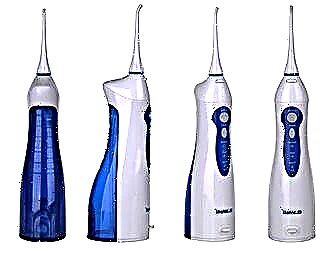The appearance of a runny nose indicates inflammation of the mucous membrane of the nasal passages. There are many reasons for this, therefore, first you need to install it, then conduct therapy. How to rinse a child's nose with a cold? Nowadays, the pharmaceutical industry offers a wide range of medicines in the form of solutions that help to quickly get rid of unpleasant symptoms. In addition, you can prepare the medicine at home using herbal ingredients.
 Rhinitis can be an independent disease or a symptom of another pathology (for example, allergies). Nasal breathing is important for both the adult and the child. Its absence is accompanied by headache, rapid fatigue and psycho-emotional disorder. In addition, children have a high risk of developing the following complications:
Rhinitis can be an independent disease or a symptom of another pathology (for example, allergies). Nasal breathing is important for both the adult and the child. Its absence is accompanied by headache, rapid fatigue and psycho-emotional disorder. In addition, children have a high risk of developing the following complications:
- otitis. When the inflammatory process spreads to the mucous membrane of the auditory tube, ventilation in the ear cavities is disturbed, secretion increases, which predisposes the activation of opportunistic flora;
- sinusitis. Nasal congestion and swelling of the nasal mucosa impair the cleansing, ventilation and drainage functions. As a result, the inflammation covers the paranasal sinuses. Congestion in combination with hypersecretion leads to the accumulation of mucus, the appearance of purulent masses;
- laryngitis. Inhalation of cold, untreated air through the mouth is fraught with sore throat;
- adenoiditis and tonsillitis. Inflammation of the tonsil tissue can be a consequence of the spread of infection from the pathological focus. In addition, hypertrophied lymphoid tissue in chronic adenoiditis can be a source of infection, since it can accumulate microbes;
- apnea. Short-term cessation of breathing during sleep is accompanied by an increase in hypoxia, which is why dysfunction of internal organs is observed. For a child, oxygen starvation is especially dangerous, since a sufficient supply of nutrients and oxygen is required for the full development of organs;
- hypotrophy. If rhinitis is diagnosed in an infant, feeding control is one of the important points of therapy. Due to the lack of nasal breathing, the act of sucking becomes difficult, so the newborn refuses to breast and quickly loses weight.
Rinsing the nose
 Nasal lavage procedures are widely used to effectively treat rhinitis. Of course, they do not bring pleasure to the child, but without them, the healing process lasts much longer.
Nasal lavage procedures are widely used to effectively treat rhinitis. Of course, they do not bring pleasure to the child, but without them, the healing process lasts much longer.
- cleansing the surface of the mucous membrane from dust particles, allergens;
- normalization of the epithelium;
- sanitation of the infectious focus;
- restoration of drainage by reducing tissue swelling;
- control over the volume of the generated secret;
- relief of breathing.
To cleanse the nose of children with medicinal solutions, you can use medications or herbal ingredients. The nasal cavities in children are much narrower than in adults, so the procedure requires accuracy and strict adherence to the rules.
Medication solutions
How can you rinse your nose? The advantages of medicinal solutions are in compliance with the exact concentration of medicinal components and the correct preparation technology.
Before prescribing therapy, the cause of the common cold should be established. Depending on it, you need to choose a remedy that has:
- antibacterial;
- anti-inflammatory;
- regenerating;
- antiseptic;
- mucolytic;
- decongestant;
- immunostimulating;
- analgesic property.
Now let's take a closer look at how to rinse a child's nose without harm to his health.
Aqua Maris
The tool is available in the form of a spray, solution for drip injection. The choice depends on the age of the little patient. Often, drops are prescribed until the age of six, and an aerosol is prescribed at an older age.
Aqua Maris is the safest solution for children, because it is based on sea water.
The group of saline solutions also includes Dolphin, Marimer, Humer, Salin, No-sol, Morenazal. You can also use a saline solution, which contains trace elements necessary for the sanitation of the cavity.
Saline (pharmacy) solution for rinsing the child's nose is recommended for any type of rhinitis. It provides a decongestant, antiseptic effect, moisturizes the mucous membrane well, strengthens its protection and accelerates the regeneration processes.
Typically, the procedure is repeated up to five times a day. The medicinal solution can be prescribed not only for therapeutic, but also for prophylactic purposes.
Furacilin
If you do not know how you can rinse your child's nose, you can stop your choice on Furacilin. It belongs to broad-spectrum solutions and does not require large material costs. The drug has a powerful antiseptic, anti-inflammatory properties, due to which it is possible to cope with an infectious rhinitis within a few days.
For preparation, a tablet form of the drug is required in a dose of 2-3 pieces, warm water with a volume of 250-350 ml. The tablets should be thoroughly crushed and dissolved in water.
Ethnoscience
How to rinse a child's nose? Now we will analyze how to make an effective solution at home. The benefits of traditional medicines include a natural composition, which allows you to minimize the risk of side effects.
A salt-based drug is prescribed from the first months of life. It cleanses the mucous membrane, moisturizes, increases resistance to irritating environmental factors.
How to prepare the solution? To do this, it is enough to dissolve the salt in warm water. For infants, the concentration of salt should be minimal (1 g per 100 ml). The recipe for a typical saline solution involves dissolving 4 g of salt in 300 ml.
If after the procedure the swelling of the mucous membrane, nasal congestion and the volume of mucous secretions increase, the spouts should be rinsed with boiled water. Next time, the concentration of salt in the solution should be much lower.
Propolis is widely used. It is known for its anti-inflammatory, antiseptic properties. In addition, it reduces tissue irritation and accelerates regeneration.
For the procedure, a 10% tincture is used. For 270 ml of warm water, 15-25 drops are enough (depending on age).
Decoction of useful plants
With a decoction of chamomile, you can not only rinse your nose, but also gargle with pharyngitis.
The healing properties of chamomile have been used for thousands of years. It has a powerful anti-inflammatory, antiseptic, decongestant effect. Due to this, its broth is widely prescribed for inflammatory diseases, not only for external use, but also for internal use.
To prepare a remedy, it is necessary to pour 60 g of chamomile into 480 ml of water. When the water boils, you need to wait 4 minutes and remove from the stove. The broth must be cooled slightly to avoid burns of the nasopharyngeal mucosa.
You can enhance the effect of chamomile, as well as prepare a separate medicinal solution, using sage, calendula, oak bark and eucalyptus.
Vegetable medicines
 Beet-based solutions can be used to rinse a child's nose with rhinitis caused by a cold. The fact is that honey and vegetables are a good breeding ground for microbes. As a result, after instillation or washing of the nasal cavities with such drugs, pathogens begin to multiply rapidly, thereby stimulating the progression of the disease.
Beet-based solutions can be used to rinse a child's nose with rhinitis caused by a cold. The fact is that honey and vegetables are a good breeding ground for microbes. As a result, after instillation or washing of the nasal cavities with such drugs, pathogens begin to multiply rapidly, thereby stimulating the progression of the disease.
For cooking, you need to peel the beets, chop, squeeze the juice.A vegetable should be chosen with an elongated shape, maroon shade, without whitish rings. It is this variety that has the maximum amount of nutrients.
The resulting juice must be mixed with warm water in an equal volume to obtain 250 ml, then add 15 g of melted honey. If you cannot mix the ingredients until a homogeneous mass is obtained, you can put the mixture in a water bath for a couple of minutes.
Procedure rules
In order to properly rinse a child's nose at home, you need to follow simple rules. This will maximize the therapeutic effect and avoid complications.
Flushing Recommendations:
- to prepare the solution, only boiled water is used (not from the tap!);
- the temperature of the solution should not exceed 40 degrees. Hot liquid can cause burns, cold liquid can irritate the mucous membranes and aggravate the course of a runny nose;
- herbal nasal rinses must be filtered before use;
- after the procedure, it is advisable to blow your nose well. This will enhance the therapeutic effect of the procedure.
For babies
To cleanse the nose with a runny nose, the child needs to take into account the age. The technique of the procedure depends on this. To cleanse the nose, the baby needs:
- moisten a cotton ball in warm water, clean the inner surface of the nose;
- using a pipette, it is necessary to drip the prepared medicinal solution, 2 drops into each nostril. If there are dry crusts, for careful removal, moisten them with a solution and wait for them to get wet;
- after a couple of minutes, remove the liquid using a special aspirator with a soft tip.

Cleansing must be done carefully, as the mucous membrane is very delicate and can be easily injured.
Child from 5 years old
You can rinse your child's nose with a runny nose in another way. It is suitable for older children:
- we select a container with a spout, pour the solution into it;
- slightly tilt the child over the bathroom;
- turn our head to the side;
- pour the solution into the superior nasal passage;
- the liquid is poured out through the other;
- repeat the procedure from the opposite side.
Blow your nose after the procedure. We emphasize that frequent washing of the nasal passages is fraught with a violation of the quantitative composition of the microflora.
Here are some more good guidelines:
- the procedure should be carried out 1-2 hours after a meal;
- after rinsing, the solution can flow out of the nose for another 20 minutes, therefore, cleansing is not indicated before bedtime;
- after the procedure, you should not immediately go outside. In winter, you need to wait 1 hour.
The procedure has some restrictions on its use. They include:
- oncological neoplasms of the nasal cavities;
- uncontrolled epilepsy;
- chronic otitis media;
- frequent nosebleeds;
- nasal congestion, which is not eliminated by vasoconstrictor agents.
The better the rules are followed, the greater the effect can be obtained from the procedure. If the technique is violated, the solution may enter the ear cavity with the development of otitis media, as well as the lower respiratory tract with the appearance of cough and bronchospasm.



